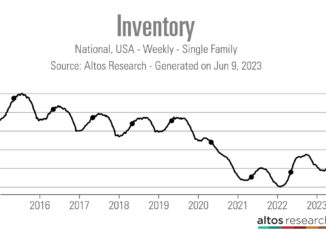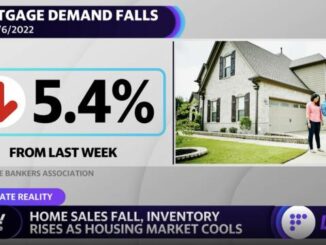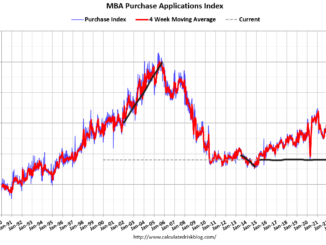
It’s the end of May and unsold inventory on the market is increasing across the U.S. Every state in the country has more homes on the market now than a year ago and, in many places, new construction is being completed and added to inventory, so it’s not just resale inventory that’s growing.
There are more homes on the market now than anytime since August 2020. This number will probably peak at about 700,000 this summer, crossing over 2020 levels at that point.
New listings climbed during the past week and there are now 72,000 more single-family homes on the market. It appeared that new listings might be on the decline already, but the pace picked up a tad this week, which is encouraging. More people coming off the sidelines to sell their homes is a healthy signal for the market.
Of course, we have to keep watching the sales rate too. No one wants a scenario in which there’s a flood of sellers but no buyers. So, it was encouraging that new pending sales ticked up a bit this week after having declined for several weeks in a row.
Altos Research tracks every home for sale in the country each week. The data so often defies expectations or changes quickly. We track all the pricing, supply and demand, sales, and all the changes in the data so you can understand immediately as it happens. Let’s look at the details of the U.S. real estate market at the end of May 2024.
Inventory
There are 595,000 single-family homes on the market now. That’s up almost 3% for the week and represents 37% more homes unsold on the market now than at this time last year.
Every state in the country now has more unsold inventory than a year ago. Some states like New York have only a fraction more unsold homes now than last year while other states like Florida have 65% more homes unsold. But, basically, inventory is still climbing everywhere as mortgage rates are still north of 7%. Higher rates create more inventory.
Rates have eased down in the past few weeks and may soon sneak back below 7%. We’ve had an ongoing trend of expanding inventory — these are the unsold homes on the market — that’s been building all year. And this trend will continue until mortgage rates drop significantly.
With nearly 600,000 homes on the market, that’s more than at anytime since the start of the COVID-19 pandemic in 2020. In a few weeks — probably early July — inventory is likely to surpass 2020 levels. Inventory will peak in late summer and is expected to end 2024 with about 620,000 single-family homes on the market, which would be about 20% more than the year prior.
In the accompanying video, the inventory chart shows a dark red line, which illustrates that unsold inventory in 2024 is consistently trending higher. And you can see how the number is set to cross over the gray line (2020) by July. You can also see the light red line from 2022 when rates were first skyrocketing. That’s when inventory started climbing up from the record-low levels during the pandemic. Inventory in 2022 was building much more quickly than it is now. Rates were jumping and so was inventory.
There might be a chance that mortgage rates finally start to meaningfully recede in the second half of the year. If mortgage rates fall quickly, you’ll see the slope of this year’s inventory line level off as homebuyer demand picks up due to increased affordability. Expect that demand to be noticeable if the 30-year fixed rate gets close to 6.5%.
New listings
There were 72,000 new listings this week. That’s up several percentage points from last week and is the most new listings of any week this year. This is good because it’s a reversal from what was assumed last week.
The volume of new sellers had been inching down for three weeks and it looked like the new-listings rate had passed its peak for the year. But this week, it jumped. As previously mentioned, any signs of rising seller volume is helpful to this market. In most years, new listings volume peaks in the second quarter, so hopefully we get a little more runway before the volume tapers off in the latter half of 2024.
There were 72,000 new listings unsold and another 18,000 listings that are already under contract (i.e., immediate sales). That equates to 90,000 new sellers this week, or 10% more than a year ago.
In 2022, however, there were 108,000 new listings during the last week of May — 20% more than today. This is important context because it helps to show that total home sales will necessarily be capped. There just aren’t enough sellers yet. But seller volume is growing and any growth in the market is good in relation to the incredibly restricted pace we’ve been on.
The three most populous states — Texas, Florida and California — each have about 20% more new listings this week than a year ago. The South has been leading inventory growth this year, but California is picking up pretty quickly. That’s something to keep an eye on.
Pending sales
There are 404,000 single-family homes in contract now. That’s up almost 1% from last week and about 1.25% more on a year-over-year basis. A few thousand more homes are under contract to close in June than there were a year ago.
There were also 68,000 new contracts started this week. That’s up almost 1% from last week and 4% more than a year ago. It’s nice to see the number of new contracts tick up, although it looks like April might have been the 2024 peak for that measurement of home sales. The peak for the year so far was a few weeks ago, when there were 78,000 new contracts started.
There will be a couple more weeks in June with potential growth in contracts before the market recedes after the July 4 holiday. There’s usually a spike in offers that happens before Independence Day.
In the video above, the pending sales chart has bars that each represent a week. The higher the bar, the more homes that are going under contract. These 404,000 pending single-family home sales will close mostly in June. The lighter portion of each bar represents the new contracts started that week, and a dotted line has been added to show where the market is compared to last year at this time. Right now, there’s just a tiny bit of growth.
Price reductions
Today, 34.8% of homes on the market include a price cut. That’s up 40 basis points from last week and is about 450 basis points above where it was at the end of May 2023. Not only is the share of homes with price cuts elevated compared to one year ago, but more price cuts are happening each week than last year.
As inventory has grown and demand has slowed due to higher mortgage rates, the houses sitting on the market need to cut their asking prices. It’s normal for there to be price cuts in every market. But now that more than one-third of listings have cut their prices — and as this trend line approaches 40% — it’s really indicative of an ongoing slowdown in demand. By July, it is possible that more than 40% of the homes on the market will have price cuts. That would be a bearish indicator for future sales prices.
In the accompanying chart, if you follow the slope of the dark red line up for another month or two, you’ll see how the market may approach 40%. These are leading indicators for sales that will happen in the future.
And mortgage rates can change this trajectory. Price cuts are more prevalent this spring because rates have stayed higher for longer. But if rates drop substantially, you’ll see a subsequent pickup in homebuyer demand that shows up in this stat through fewer price cuts. Keep a lookout.
Home prices
Since price reductions are a leading indicator of future sales prices, Altos Research is watching price signals to see if sales prices are showing any weakness. While we’ve been sharing for a few weeks that it looks like there’s weakness in future sales prices, most of the home price metrics do not yet show receding growth. Most indicators are still showing 3% to 4% growth over last year.
The median price of all U.S. single-family homes on the market today is $454,000. That’s up almost 1% from last week and is slightly higher than in late May 2023.
The median price of the homes in contract is $400,000, which is almost 4% more than a year ago. Take a look at the pending sales chart and the dark line, which shows all of the homes that are in escrow right now. These are sales that will close mostly in June. So, we can see that they’re almost 4% more expensive than at this time last year.
You’ll also see in the chart how home sales cluster around the big round numbers. The median price of pending sales has been basically at $400K for the past eight weeks. You can see a long stretch at $375K in 2022 (the light red line). Since sale prices cluster around these numbers, and the median is the middle for all them, it’s likely that the median stays at the same number for several weeks in a row.
You can also see in this chart how we’re probably at peak pricing for the year. Starting in June or July, prices will start to tick down during the second half of 2024. The chart for pending home sales prices is worth watching because this is the earliest proxy for sales that will close in the future.
In 2022, it was a really clear signal when prices were falling sequentially (see the gray zones). In June and October 2022, we could clearly see the effect of the rapidly rising interest rates of that time.
We’re watching for that again today. But here’s the thing: It seems like we might be finally past the peak of mortgage rates. Rates have been inching downward. The newest inflation data was positive. So, the question is, at what rate level is buyer demand stimulated and does it impact prices? Conversely, what if inflation surprisingly goes the other way and mortgage rates rise again? How quickly will that impact home prices? It’ll be quick and we’ll see it right here. The market is showing signs of growth, but homebuyers are obviously sensitive to the cost of money.



